#Alaskan plants
Text
Cow Vetch is a Highly Useful and Beautiful Weed
Cow Vetch is a Highly Useful and Beautiful Weed tells readers some interesting facts about cow vetch and other members of the pea family. It then shows readers a couple of examples of the gorgeous flowers.
Vetch
Part of the amazing beauty of the southern Alaskan coast has to be credited to it’s gorgeous plant life. The mountains, rocky cliffs, glaciers, and colorful tundra are definitely also contributors, but none of those would be as stunning without the lush vegetation. Along with lots of tall, white spruce, pine trees, and willows, the rainy weather encourages growth of a thick understory as…

View On WordPress
#Alaskan plants#Alaskan wildflowers#bird vetch#blue vetch#boreal vetch#colorful wildflowers#cow vetch#Fabaceae#flowers on racenes#pea family#photography#purple wildflowers#tufted vetch#vetch#wildflower photographs#wildflower photography#wildflowers
7 notes
·
View notes
Photo

San Francisco Landscape Vertical Garden
A picture of a medium-sized modern front yard.
#alaskan yellow cedar fence#yellow cedar fence#steel railing#wood garden wall#alaskan yellow cedar wall#planted garden fence#garden wall
0 notes
Photo

San Francisco Landscape Vertical Garden
A picture of a medium-sized modern front yard.
#alaskan yellow cedar fence#yellow cedar fence#steel railing#wood garden wall#alaskan yellow cedar wall#planted garden fence#garden wall
0 notes
Photo

San Francisco Uncovered Deck
An illustration of a medium-sized, modern side yard deck with no cover
#alaskan yellow cedar wall#yellow cedar fence#steel railing#wood garden wall#garden wall#planted garden wall
0 notes
Photo

Vertical Garden in San Francisco
Photo of a mid-sized contemporary front yard landscaping.
0 notes
Photo

San Francisco Uncovered Deck
An illustration of a medium-sized, modern side yard deck with no cover
#alaskan yellow cedar wall#yellow cedar fence#steel railing#wood garden wall#garden wall#planted garden wall
0 notes
Photo

An image of a medium-sized modern front yard.
Photo of a mid-sized contemporary front yard landscaping.
#solid fence#wood privacy fence#alaskan yellow cedar deck#garden fence#planted garden fence#garden wall
0 notes
Note
I‘m very late but, scrolling through all the beautiful art I missed, the photographs of where you live are very interesting! They remind me of Alaskan landscapes and foliage 100%, and a little bit of Scottish highland forests. It’s not important but I wanted to ask, do you know what the plant with the white flowers in the foreground of a couple of your summer forest pictures is? I‘m a plant nut & am interested to see if it‘s a plant Finland and Scotland share or not. No worries if not. Thanks for sharing!
That's interesting, I knew northern Finland had some things in common with Alaska but I never considered our landscapes could be similar to Scottish scenery.


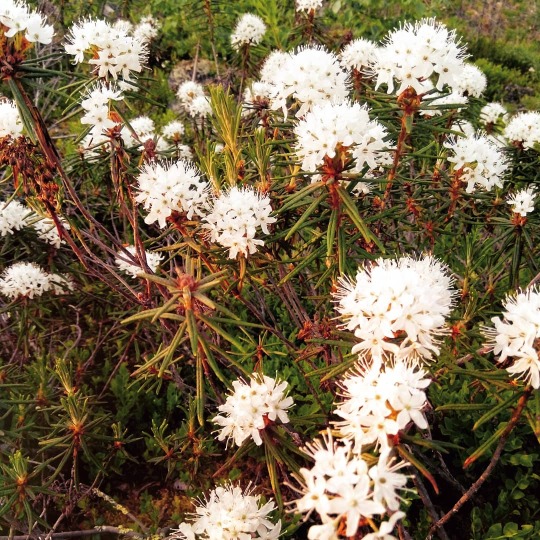
You mean this plant? It's Rhododendron tomentosum, and it seems like it's called marsh Labrador tea, northern Labrador tea or wild rosemary in English, suopursu in Finnish. They grow abundantly in swamps and pine/spruce forests and bloom intensely around June and July. They smell amazing too, strongly enough to cause headaches in some people, but personally I love it, one of my favorite wild flowers and favorite nature smells for sure. They were/have been used as herbal medicine for centuries, mainly to treat rheumatism and skin conditions, despite them being mildly poisonous.
#it looks like they grow in northern usa&alaska canada greenland and all over northern eurasia#answered#worshipthesquid#also you're not late I habitually answer asks from MONTHS ago#time doesn't move linearly here I refuse to be constrained by modern social media's artificial hecticity
240 notes
·
View notes
Text
Making Better State Insects
So at some point I stumbled across a list of State Insects. Honestly I wasn't even aware states had "state insects", but as I looked down the list my disappointment grew. A vast majority of states had selected the European honeybee (which is not even native) as their state insect, with monarch butterflies and ladybugs being the two runner ups. I thought this was a damn shame because there's so many interesting insects in the US, so I'm making a better official new list of state insects.
For this list my criteria are:
Insect must be native to the state
No repeats
Insect must be easily observable to the naked eye
I also had general guidelines of picking insects that were relatively common (based on inaturalist heat maps of observation) and picking insects that were cool or interesting. Some of these insects I picked because I thought they were important parts of the areas culture and experience (lovebugs, toebiters, and periodical cicadas) and some insects I picked just to raise awareness that they exist in the US.
I also don't think I gave anyone huge L's, no mosquitoes, louses, cockroaches, ect, because my goal of this list is to get people interested in their native insects and I want it to be fun to find and observe your state insect.
Also some states get gold stars for picking state insects that already meet these criteria and are cool so they get to keep theirs. Some states also have "state butterflies" or "state agricultural insect" which for this list I'm ignoring, you can keep those I'm just focused on state insects. Slight disclaimer also, I've only ever lived in California, Nevada, Oregon, Washington, and South Carolina, and all these states are keeping their original state insect. So all the insects I'm choosing are for states I haven't lived in. Also I'm not including photos in this post just for my own sanity.
List under the cut!
Alabama
Old: Monarch Butterfly
New: Giant Leaf-footed Bug (Acanthocephala declivis)
Leaf-footed bugs are cute, they're big, they're stanced up, the males have big back legs, you've probably seen them. Being true bugs they have piercing mouthparts and suck plant juices.
Alaska
Four-spot Skimmer (Libellula quadrimaculata)
Alaska gets to keep their old state insect, it's a cool dragonfly and apparently was partially chosen to honor bush pilots who fly to deliver supplies in the Alaskan wilderness, so really cool!
Arizona
Two-tailed swallowtail butterfly (Papilio multicaudata)
Arizona also gets to keep their state insect. Kind of a shame because Arizona has a lot of cool species, but it did meet my requirements and they get points for choosing a different kind of butterfly.
Arkansas
Old: European honeybee
New: North American Wheel Bug (Arilus cristatus)
One of the largest assassin bugs in the US, these guys are appreciated by gardeners for their environmentally friendly pest control. They also look badass.
California
California Dogface Butterfly (Zerene eurydice)
Endemic to California and on a stamp! Again, kind of a shame because there's a lot of cool insects in California, but I respect this choice, especially since California was the first state to designate a state insect (1929).
Colorado
Colorado Hairstreak Butterfly (Hypaurotis crysalus)
Same deal as California, the state's name is in the common name, unique butterfly found in the four corners region. Just get a stamp or something soon!
Connecticut
Old: European Praying Mantis
New: Cecropia Moth (Hyalophora cecropia)
You picked a state insect no one else had but went with a nonnative mantis? Here's an insect that'll make you stand out and it's a native species. Lesser known than some of the other giant silk moths, the Cecropia moth is the largest native moth and has some truly stunning colors.
Delaware
Old: Convergent Ladybeetle
New: Periodical Cicada (Magicicada septendecim)
Cicada's had to be somewhere on this list and Delaware was one of the main hotspots for brood X, one of the largest broods of the multiple staggered brood cycles. Hey, they have a lot of history in America. Accounts go back as early as 1733, with Thomas Jefferson and Benjamin Franklin making a note of them.
District of Columbia
Old: None
New: Monarch Butterfly (Danaus plexippus)
The Entomological Society of America is trying to get the Monarch Butterfly added as our national insect, so I think that's reason enough to let DOC claim it.
Florida
Zebra Butterfly (Heliconius charithonia)
Florida gets to keep their state butterfly, but the populations that have existed in Florida are in steep decline. Ideally I would want being the official state insect to come with some protections, hopefully people can get invested in reintroducing them.
Georgia
Old: European Honeybee
New: Horned Passalus Beetle (Odontotaenius disjunctus)
Also called bess beetles or patent-leather beetles, these cute guys are important for forest systems because they eat decaying wood, helping to break down felled trees. They're cute beetles that squeak when disturbed.
Hawaii
Kamehameha Butterfly (Vanessa tameamea)
An endemic Hawaiian butterfly named after a ruling dynasty of Hawaii. Their population is under threat, as with a lot of native Hawaiian species, so I think this is a good state insect to build protections and activism around.
Idaho
Old: Monarch Butterfly
New: Ice Crawler (Grylloblatta sp. "Polaris Peak")
Look Idaho, I have to admit that even though I've traveled extensively through WA, OR, CA, and NV I've never stepped foot in Idaho and I don't intend to. Your state exists in a weird liminal zone, not really the pacific northwest but not really whatever Montana is either. Your state isn't even all in one time zone. So look, I really wanted ice crawlers to be on this list, but they're exclusively found on mountains in the pacific northwest and Sierra Nevadas. Normally I would've given them to Washington or Oregon, but those states already have state insects that work for them. So your state gets ice crawlers, and they do exist in Idaho in the panhandle. It's not an L, ice crawlers are amazing extremophiles that crawl over snow in high elevation mountain peaks. They exist in their own unique order and theres only one genus in the US, with different species being region locked, sometimes onto specific mountains. Their thermoregulation is so delicate, the warmth of someones hand holding them causes them to over heat and die. They're cool, unique, and weird, and let's face it so is your state. At least I didn't take a cop out by picking the potato bug.
Illinois
Old: Monarch Butterfly
New: Red-banded Leafhopper (Graphocephala coccinea)
Leafhopper done Chicago style.
Indiana
Old: Say's Firefly
New: Common True Katydid (Pterophylla camellifolia)
I wanted to give you Say's Firefly. I really did. But when I looked on Inaturalist not A SINGLE OBSERVATION was listed for the species in Indiana. I'm even going to post pictures.
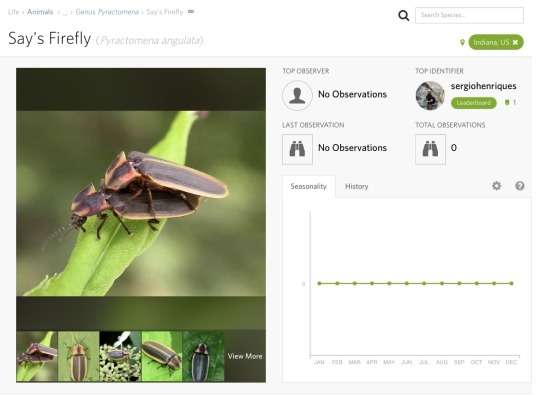
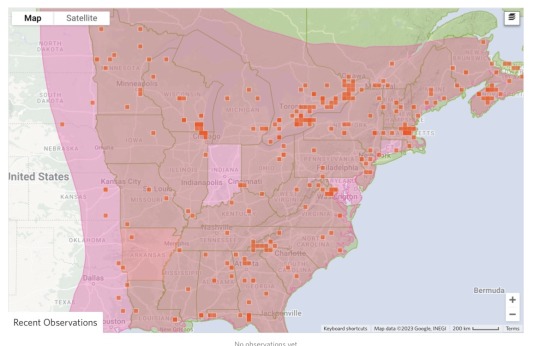
So even though this is extremely funny I'm giving your state the Common True Katydid instead. Large, loud, and easy to spot, these guys can frequently be heard chirping in trees. Not only do different populations have different rates of chirp, but the rate of chirp is also so predictably dependent on temperature that you could make an equation to tell the temperature based on chirp rate.
Iowa
Old: None
New: Westfall's Snaketail (Ophiogomphus westfalli)
Really cool clubtail dragonfly that's almost exclusively found in Iowa, Missouri, and Arkansas.
Kansas
Old: European Honeybee
New: Rainbow Scarab (Phanaeus vindex)
A kind of true dung beetle, they play an important role in removing waste. And although they don't roll waste like the stereotypical dung beetles, they are extremely pretty.
Kentucky
Viceroy Butterfly (Limenitis archippus)
This is fine.
Louisiana
Old: European Honeybee
New: Lovebug (Plecia nearartica)
Look, one of the southern states was going to get this one and Louisiana has a majority of the observations for them. Although annoying, it's things like having to scrape thousands of flies off your car that makes the Southern experience. Embrace it!
Maine
Old: European Honeybee
New: Brown Wasp Mantidfly (Climaciella brunnea)
I really wanted these guys to be somewhere on the list. Neither a wasp, mantis, or fly, these are predatory neuropterans related to lacewings. They have raptorial front legs (resembling a mantis) and their coloration resembles paper wasps that they live alongside. Weird, unique, and wonderful!
Maryland
Baltimore Checkerspot Butterfly (Euphydryas phaeton)
This butterfly might've been picked for the resemblance of the state flag. It's in decline in it's native range, so hopefully more awareness and consideration to state insects will help push conservation efforts.
Massachusetts
Old: Ladybug
New: Hornet Clearwing Moth (Paranthrene simulans)
Hornet mimic moth, the caterpillars feed on chestnuts and oaks. All lepidopterans (moths and butterflies) have modified hairs on their wings that form the "scales" that give this order their name. For this moth though, parts of it's wings don't have any scales so it more convincingly resembles a hornet. Underneath the scales, butterfly and moth wings look pretty much like any other insect's wing. Cool!
Michigan
Old: None
New: American Salmonfly (Pteronarcys dorsata)
The biggest salmonfly in North America. They make excellent fishing bait, and several fly fisherman use salmonfly lures to catch trout. Their nymphs are also an important indicator of water quality, with them being one of the first species to disappear in the presence of pollution or contaminants.
Minnesota
Old: Monarch Butterfly
New: American Giant Water Bug (Lethocerus americanus)
Also one of the ones that had to be on the list somewhere, and the Inat heatmap says Minnesota. Toebiters are part of the experience, and they are cool and ferocious looking.
Mississippi
Old: European Honeybee
New: Eastern Eyed Click Beetle (Alaus oculatus)
Click beetles have a cool adaption that allows them to launch themselves in the air to avoid predators. This makes an audible sound, hence their common name. The Eastern Eyed Click Beetle is one of the largest and most striking click beetles in the US, with large false eyespots on their thorax.
Missouri
Old: European Honeybee
New: Goldenrod Soldier Beetle (Chauliognathus pensylvanicus)
A soldier beetle that feeds on aphids and small plant pests, these beetles also eat pollen and nectar from flowers. They don't harm the flower, and though their common name reflects their preference for goldenrod flowers, they're also an important pollinator of the prairie onion (Allium stellatum). This is a native species of onion that grows from Minnesota to Arkansas.
Montana
Old: Mourning Cloak
New: Western Sheep Moth (Hemileuca eglanterina)
Mourning Cloak butterflies do technically work for my criteria, but I wanted to showcase some more regional insects in this as well, as Mourning Cloaks are found throughout North America and Eurasia. The Western Sheep Moth is an absolutely stunning giant silk moth, found throughout the western United States. Although not as big as some other silk moths, the bold orange and black coloration on these make them absolutely stand out.
Nebraska
Old: European Honeybee
New: Blowout Tiger Beetle (Cicindela lengi)
A tiger beetle with unique patterns, these guys are active predators and are particularly difficult to spot because they run extremely quickly. They seem to be pretty cold tolerant and exist from Colorado up into Canada.
Nevada
Vivid Dancer Damselfly (Argia Vivida)
This damselfly was picked as Nevada's state insect because it's widespread throughout the state and matches the state colors, silver and blue. That gets my seal of approval!
New Hampshire
Two-spotted Lady Beetle (Adalia bipunctata)
This is fine.
New Jersey
Old: European Honeybee
New: Margined Calligrapher (Toxomerus marginatus)
A pretty hoverfly, they strongly resemble bees in both looks and behavior. Larvae feed on common plant pests such as thrips and aphids, while the adults sip nectar and pollinate flowers. These helpful attributes make it something the Garden State can appreciate!
New Mexico
Tarantula Hawk (Pepsis grossa)
New Mexico wins the official state insect list by a landslide. Not only is the tarantula hawk a super cool and formidable insect to showcase, but New Mexico's state butterfly (Sandia Hairstreak) was discovered in New Mexico. No notes 10/10!
New York
Nine-spotted Lady Beetle (Coccinella novemnotata)
A native species of lady beetle that's been in decline in recent years, New York is one of the last remaining states where they've been spotted. I also appreciate that New York designated a specific ladybug species instead of just saying "Coccinellidae species".
North Carolina
Old: European Honeybee
New: Eastern Rhinoceros Beetle (Xyloryctes jamaicensis)
A large native species of rhinoceros beetle. They breed in ash trees, and are under threat due to competition from the Emerald Ash Borer.
North Dakota
Old: None
New: Nuttall's Blister Beetle (Lytta nuttalli)
As with all blister beetles, these guys have a chemical defense. Unlike the more famous Bombardier Beetle thought, instead of being black and red they are iridescent red/purple and green.
Ohio
Old: Ladybug
New: Bald-faced Hornet (Dolichovespula maculata)
Look, when the one thing everyone knows about your state is that it sucks, it's time to lean into it. Bald-faced hornets, everyone knows them, everyone has opinions about them, and they get a lot of attention. I don't think I have to explain this one anymore.
Oklahoma
Old: European Honeybee
New: Giant Walking Stick (Megaphasma denticrus)
The largest insect in the United States. Being a native walking stick, they're less damaging than the imported invasive walking sticks that are heavily controlled.
Oregon
Oregon Swallowtail Butterfly (Papilio oregonius)
Oregon in the common name and in the species name, and also has a stamp!
Pennsylvania
Pennsylvania Firefly (Photuris pensylvanica)
Pennsylvania in the common name and species name. If fireflies weren't already on this list I would've made sure to include them somewhere.
Rhode Island
American Burying Beetle (Nicrophorus americanus)
When I saw this on the list I was worried. American Burying Beetles are one of my favorite insects, but they're extremely endangered now. I also thought they existed more in the midwest, so I was worried I would have to change this one because it violated the "native to the region" rule. But! To my pleasant surprise, not only did their historic range extend to Rhode Island, but there is actually a carefully maintained wild population on Block Island. They estimate between 750-1000 individuals live there, making it one of the few remaining places where the American Burying Beetle still exists. Excellent work Rhode Island!
South Carolina
Carolina Mantis (Stagmomantis carolina)
This is fine. I wanted to give South Carolina the Palmetto bug but they're actually not native.
South Dakota
Old: European Honeybee
New: Golden Northern Bumble Bee (Bombus fervidus)
"Save the bees" should really be focused on native pollinators, many of whom are in decline. There are a lot of species of native bee you can feature as a state insect, with the Golden Northern Bumble Bee being a particularly large and striking species.
Tennessee
Old: Firefly and ladybug
New: Black-waved Flannel Moth (Megalopyge crispata)
Seriously look them up, these guys are adorable.
Texas
Old: Monarch Butterfly
New: Rainbow Grasshopper (Dactylotum bicolor)
It was really hard to pick an insect for your state. The Texas Unicorn Mantis was a contender but I eliminated it because it's really only found in the southern part of Texas, so it was between the Rainbow Grasshopper and the Eastern Velvet Ant (or Cow Killer). I went with the Rainbow Grasshopper because it's more wide spread and common, and occurs everywhere except the east part of Texas. But the Eastern Velvet Ant only occurs on the east part of Texas, maybe you should get an East and West Texas insect? I also thought more people have probably already heard of the Eastern Velvet Ant than the Rainbow Grasshopper, which is a shame because they're super interesting to look at.
Utah
Old: European Honeybee
New: Mormon Cricket (Anabrus simplex)
Mormon Crickets are not true crickets, and instead closer related to katydids. Their common name comes from an early account of Latter-day Saint settlers in Utah. In 1848, a swarm of Mormon Crickets decimated the settler's crops, so the legend goes that they prayed for relief from this plague of insects. Later that year, a swarm of gulls appeared and ate the crickets, thus saving the crops. This is recounted in the "miracle of the gulls" story. To recognize their contributions, the California Gull is commemorated as Utah's state bird. I thought it was fitting then that the Mormon Cricket be recognized as your state insect.
Vermont
Old: European Honeybee
New: Long-tailed Giant Ichneumon Wasp (Megarhyssa macrurus)
A pretty wasp with an extremely long ovipositor, these wasps are common in deciduous forests across the eastern United States. They can't sting, and instead use their long ovipositor to stab into tree bark and deposit eggs on the horntail larvae that burrow into the trees.
Virginia
Old: Eastern Tiger Swallowtail Butterfly
New: Giant Stag Beetle (Lucanus elaphus)
A large stag beetle native to the Eastern United States. Although not as well known as their similar looking fellow stag beetles from Japan, these guys are a lovely chocolate brown instead of solid black. Like most stag beetles, they breed in decaying wood.
Washington
Green Darner Dragonfly (Anax junius)
I imagine this was chosen because it matches the flag.
West Virginia
Old: European Honeybee
New: Appalachian Tiger Beetle (Cicindela ancocisconensis)
This tiger beetle likes hilly terrain. As with all tiger beetles, they can be hard to spot because they run across the ground in search of prey. They are fast! But this can make it more rewarding when you finally catch up to one.
Wisconsin
Old: European Honeybee
New: Phantom Crane Fly (Bittacomorpha clavipes)
Don't believe old wive's tales about crane flies drinking gallons of blood, they are nonbiting. Those striking black and white legs are hollow, and are held out when they fly, making an extremely distinct sight that's been likened to sparklers or snowflakes.
Wyoming
Sheridan's Hairstreak (Callophrys sheridanii)
This is fine.
#insect#insects#state insect#long post#list#text post#entomology#bugblr#invertebrates#invertiblr#inverts#invert
190 notes
·
View notes
Text
Inupiaq Books
This post was inspired by learning about and daydreaming about visiting Birchbark Books, a Native-owned bookstore in Minneapolis, so there will be some links to buy the books they have on this list.
Starting Things Off with Two Inupiaq Poets
Joan Naviyuk Kane, whose available collections include:
Hyperboreal
Black Milk Carbon
The Cormorant Hunter's Wife
She also wrote Dark Traffic, but this site doesn't seem to carry any copies
Dg Nanouk Okpik, whose available collections include
Blood Snow
Corpse Whale
Fictionalized Accounts of Historical Events
A Line of Driftwood: the Ada Blackjack Story by Diane Glancy, also available at Birchwood Books, is a fictionalized account of Ada Blackjack's experience surviving the explorers she was working with on Wrangel Island, based on historical records and Blackjack's own diary.
Goodbye, My Island by Rie Muñoz is a historical fiction aimed at younger readers with little knowledge of the Inupiat about a little girl living on King Island. Reads a lot like an American Girl book in case anyone wants to relive that nostalgia
Blessing's Bead by Debby Dahl Edwardson is a Young Adult historical fiction novel about hardships faced by two generations of girls in the same family, 70 years apart. One reviewer pointed out that the second part of the book, set in the 1980s, is written in Village English, so that might be a new experience for some of you
Photography
Menadelook: and Inupiaq Teacher's Photographs of Alaska Village Life, 1907-1932 edited by Eileen Norbert is, exactly as the title suggests, a collection of documentary photographs depicting village life in early 20th century Alaska.
Nuvuk, the Northernmost: Altered Land, Altered Lives in Barrow, Alaska by David James Inulak Lume is another collection of documentary photographs published in 2013, with a focus on the wildlife and negative effects of climate change
Guidebooks (i only found one specifically Inupiaq)
Plants That We Eat/Nauriat Niģiñaqtuat: from the Traditional Wisdom of Iñupiat Elders of Northwest Alaska by Anore Jones is a guide to Alaskan vegetation that in Inupiat have subsisted on for generations upon generations with info on how to identify them and how they were traditionally used.
Anthropology
Kuuvangmiut Subsistence: Traditional Eskimo Life in the Latter Twentieth Century by Douglas B. Anderson et al details traditional lifestyles and subsistance customs of the Kobuk River Inupiat
Life at the Swift Water Place: Northwest Alaska at the Threshold of European Contact by Douglas D. Anderson and Wanni W. Anderson: a multidisciplinary study of a specific Kobuk River group, the Amilgaqtau Yaagmiut, at the very beginning of European and Asian trade.
Upside Down: Seasons Among the Nunamiut by Margaret B. Blackman is a collection of essays reflecting on almost 20 years of anthropological fieldwork focused on the Nunamiut of Anuktuvuk Pass: the traditional culture and the adaption to new technology.
Nonfiction
Firecracker Boys: H-Bombs, Inupiat Eskimos, and the Roots of the Environmental Movement by Dan O'Neill is about Project Chariot. In an attempt to find peaceful uses of wartime technology, Edward Teller planned to drop six nukes on the Inupiaq village of Point Hope, officially to build a harbor but it can't be ignored that the US government wanted to know the effects radiation had on humans and animals. The scope is wider than the Inupiat people involved and their resistance to the project, but as it is no small part of this lesser discussed moment of history, it only feels right to include this
Fifty Miles From Tomorrow: a Memoir of Alaska and the Real People by William L. Iģģiaģruk Hensley is an autobiography following the author's tradition upbringing, pursuit of an education, and his part in the Alaska Native Settlement Claims Act, where he and other Alaska Native activists had to teach themselves United States Law to best lobby the government for land and financial compensation as reparations for colonization.
Sadie Bower Neakok: An Iñupiaq Woman by Margaret B. Blackman is a biography of the titular Sadie Bower Neakok, a beloved public figure of Utqiagvik, former Barrow. Neakok grew up one of ten children of an Inupiaq woman named Asianggataq, and the first white settler to live in Utqiagvik/Barrow, Charles Bower. She used the out-of-state college education she received to aid her community as a teacher, a wellfare worker, and advocate who won the right for Native languages to be used in court when defendants couldn't speak English, and more.
Folktales and Oral Histories
Folktales of the Riverine and Costal Iñupiat/Unipchallu Uqaqtuallu Kuungmiuñļu Taģiuģmiuñļu edited by Wanni W. Anderson and Ruth Tatqaviñ Sampson, transcribed by Angeline Ipiiļik Newlin and translated by Michael Qakiq Atorak is a collection of eleven Inupiaq folktales in English and the original Inupiaq.
The Dall Sheep Dinner Guest: Iñupiaq Narratives of Northwest Alaska by Wanni W. Anderson is a collection of Kobuk River Inupiaq folktales and oral histories collected from Inupiat storytellers and accompanied by Anderson's own essays explaining cultural context. Unlike the other two collections of traditional stories mentioned on this list, this one is only written in English.
Ugiuvangmiut Quliapyuit/King Island Tales: Eskimo Historu and Legends from Bering Strait compiled and edited by Lawrence D. Kaplan, collected by Gertrude Analoak, Margaret Seeganna, and Mary Alexander, and translated and transcribed by Gertrude Analoak and Margaret Seeganna is another collection of folktales and oral history. Focusing on the Ugiuvangmiut, this one also contains introductions to provide cultural context and stories written in both english and the original Inupiaq.
The Winter Walk by Loretta Outwater Cox is an oral history about a pregnant widow journeying home with her two children having to survive the harsh winter the entire way. This is often recommended with a similar book detailing Athabascan survival called Two Old Women.
Dictionaries and Language Books
Iñupiat Eskimo Dictionary by Donald H. Webster and Wilfred Zibell, with illustrations by Thelma A. Webster, is an older Inupiaq to English dictionary. It predates the standardization of Inupiaq spelling, uses some outdated and even offensive language that was considered correct at the time of its publication, and the free pdf provided by UAF seems to be missing some pages. In spite of this it is still a useful resource. The words are organized by subject matter rather than alphabetically, each entry indicating if it's specific to any one dialect, and the illustrations are quite charming.
Let's Learn Eskimo by Donald H. Webster with illustrations by Thelma A. Webster makes a great companion to the Iñupiat Eskimo Dictionary, going over grammar and sentence structure rather than translations. The tables of pronouns are especially helpful in my opinion.
Ilisaqativut.org also has some helpful tools and materials and recommendations for learning the Inupiat language with links to buy physical books, download free pdfs, and look through searchable online versions
132 notes
·
View notes
Note
what poison/s were used in riverstar's heir at moth's celebration and when bright and flowerstar ate together?
suggestion (if you hadn't decided yet): Monkshood/Aconite/Wolfsbane (Aconitum napellus)
its a VERY poisonous plant native to the uk and europe, lethal with both ingestion and body contact and has historical use in killing and murder. symptoms appear quickly and death often comes in only a few hours; its a shame it wasn't used in canon lmao
Oh symptoms don't just appear quickly-- Aconite's name is said to be ancient Greek for "Without Dust." That refers to how aconite kills SO quickly that you will not even kick up dust in your death struggle. Death coming in a few hours is from the minimum deadly dosage, any good assassin worth their salt would use more (and take care to mask its bitter taste, it's not a subtle flavor like cyanide is.)
Forget "deathberries." Yew is nothing next to aconite.
Yew's deadly compound, taxine, acts by stopping your heart. Yawn. Aconite targets your heart, liver, kidneys, AND brain all at the same time. It's so potent that handling young roots will make your hands go numb. Only 2 miligrams of the deadly compound, aconitine, is a fatal dose in a human being; a single grain of rice weighs 20 miligrams.
Anon, my friend, you undersold aconite. It's not just a very poisonous plant in Europe, aconitine is top 5 deadliest poisons period. Members of the aconite family are widespread through the northern hemisphere-- indigenous Alaskan people have used it to hunt whales for tens of thousands of years. Its toxic properties break down within 24 hours, leaving the meat completely safe to eat.
So naturally, suggestion accepted. This is going to be SICK.
Especially since no one will be able to tell what happened. It looks like every major poison because it is. You might assume it was some kind of toxic cocktail from the symptoms. Convulsions, rapid heartrate, vomiting, numbness. It looks like yew, nightshade, and bryony all at once.
It'll be very easy for Bright Whisker to survive this and shake off suspicion simply by poisoning herself with a small amount of something else. If I go with Maple Whisker being a sibling instead of a cousin, I could have her simply join their meal a little late and realize that her mouth feels numb, just as everyone else enters convulsions, so she spits it out.
(Autism win! Avoided a poisoning because texture bad! Maybe she was waiting for the food to cool down too lmao)
And LASTLY... Aconite is Wolf's Bane. I think this is a really cool place to see the earliest incarnation of the Wolf Motif that will later show up in Bluestar's family. It tickles my brain a bit to think of Flowerstar somehow having the "hood" shape of the flower, and then she loses her first life in her gambit to poison the wolf among sheep.
I also had a stroke of inspiration and had an idea for one of the BB!DOTC cats, too. Dappled Pelt gets massively neglected in canon, imo, and I could set up the wolf thing even earlier. African Wild Dog time (painted wolf.)
#better bones au#bone babble#riverstar's heir#BB!Maplewhisker#BB!Brightwhisker#BB!Flowerstar#tw poison#cw poison#aconite
127 notes
·
View notes
Text
What Are Mosquitoes Good For?
Originally posted at my blog at https://rebeccalexa.com/what-are-mosquitoes-good-for/
Now that the weather has cooled down over much of the United States, insects have died back or gone into hibernation for the winter. So you may be tempted to be glad that the mosquitoes have disappeared for the time being. Maybe you even wish they wouldn’t come back next year! After all, they’re just mosquitoes, which annoy us and spread diseases, right? What are mosquitoes good for, anyway?
Much to the surprise of a lot of people, they actually have some pretty important ecological functions, and your local ecosystem would likely suffer if the mosquitoes were all exterminated. So today, I am going to be a mosquito apologist.
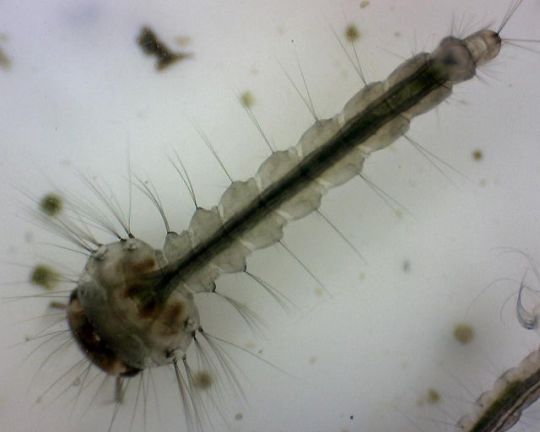
What Are Mosquitoes Good For? Food!
You may have seen hundreds or even thousands of mosquito larvae swimming in a pond or other fresh water. Perhaps you thought every single one of them came to find you after they became adults! They certainly are prolific; some species can lay as many as 300 eggs at once.
But this isn’t just because they want to have more young to annoy you, generation after generation. Rather, it’s because a lot of mosquitoes end up eaten before they even get a chance to reproduce. As eggs and larvae, they’re food for fish, amphibians, and aquatic insects and other arthropods. Once they take to the wing, birds and bats become major predators, as do adult dragonflies and other winged insects, plus spiders that catch them in their webs. While a single bat might not actually eat 1000 mosquitoes in a night, all those various predators do take a significant chunk out of the mosquito population.
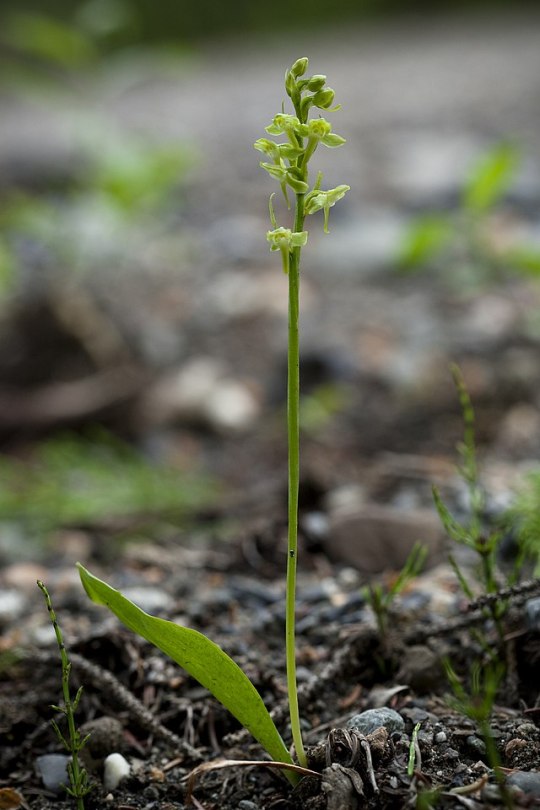
Platanthera obtusata is just one of many orchids that rely on mosquitoes for pollination.
What Are Mosquitoes Good For? Pollination!
Believe it or not, most mosquitoes aren’t out for your blood! The majority of mosquito species are entirely vegetarian; it’s only a few in which the females seek out blood to help produce eggs. Most mosquitoes drink nectar or plant sap, and in the pursuit of the former they play a vital role in pollinating the flowers they visit. Goldenrod and orchids are just two examples of groups of plants pollinated by mosquitoes. And while mosquitoes might drive Alaskans buggy, they are vital for pollination during the short Arctic summer.
What Are Mosquitoes Good For? Keeping Things in Check!
Mosquito larvae spend anywhere from a few days to a few weeks in the water where they hatched. They feed on a variety of bacteria, algae, and other microorganisms. Because they have a lot of growing to do, and need to prepare for their final molt to adult form, they have to eat a lot! That means they help keep their prey species’ populations in check. An overgrowth of algae, for example, can reduce the amount of sunlight that submerged plants have access to, and as the algae dies it increases the amount of nitrogen in the water. By constantly grazing on algae, mosquito larvae are helping to prevent these sorts of ecological imbalances.
What If We Made Mosquitoes Go Extinct?
So what are mosquitoes good for? Quite a lot, apparently! However, there’s no denying some species have also caused us a lot of grief. There have been calls to exterminate all mosquitoes, or at least every species that could ostensibly cause us problems through disease transmission. And to be sure, I don’t want to see people dying of malaria or West Nile virus, especially as these diseases often hit disadvantaged populations harder, with fewer resources for treatment. But it’s something where we need to weigh the consequences carefully.
What would happen if there were suddenly no more mosquitoes? Sure, the animals that prey on them could potentially find other sorts of food, but there would be an upset in the food web as the predators put more pressure on remaining prey species, which could lead to some of those species become locally endangered or even extirpated. Or the predators might drop in number as they failed to find enough food. Either way, getting rid of all the mosquitoes would have a negative impact on the food web.
Finally, and possibly most importantly–we may not fully understand the ecological roles mosquitoes have. As I wrote recently, ecosystems are incredibly complex networks of relationships among thousands of species, and for centuries we have been eradicating entire species without any thought as to what long-term effects their loss might have on their native ecosystems.

However, that brings up another point: the fact that there are invasive mosquitoes. Invasive species wreak havoc on ecosystems they’re introduced to, and it just so happens that one of the most notorious disease-spreading mosquitoes, Aedes aegypti, is invasive across much of the tropics, as well as subtropical and temperate areas worldwide. Spread through the slave trade, this mosquito is a prime vector for yellow fever, dengue fever, Zika, and several other pathogenic diseases affecting humans. Its cousin, Aedes albopictus, is also a disease vector and is more cold-hardy, meaning it could spread even further.
What’s the answer? Well, historically people just drained wetlands, much to the devastation of the native ecosystems there. More recently, the widespread and indiscriminate use of pesticides like DDT also knocked back mosquito populations (at least temporarily), but also killed off many other animals both directly and indirectly, to include nearly wiping out multiple raptor species due to eggshell thinning. Moreover, mosquitoes have developed resistance to pesticides, making them a less useful tool overall.
More recent innovations to control specific invasive mosquitoes hold some promise. A. aegypti, for example, has been genetically modified in labs to create a strain known as OX513A. Not only do the offspring die before they can reproduce, even if a OX513A breeds with a wild mosquito, but the offspring also apparently lack resistance to some pesticides. Biological control using Wolbachia bacteria inhibits A. aegypti‘s reproduction, and also makes them unable to carry certain diseases such as Zika and dengue fever.
So it would appear that the fight to control invasive species also has the bonus effect of stopping the mosquitoes most likely to give the rest a bad name.
Did you enjoy this post? Consider taking one of my online foraging and natural history classes, checking out my other articles, or picking up a paperback or ebook I’ve written! You can even buy me a coffee here!
#mosquito#mosquitoes#insects#invertebrates#arthropods#wildlife#wild animals#animals#entomology#biology#ecology#invasive species#nature#natural history#bugs#long post#environment#environmentalism#conservation
822 notes
·
View notes
Text
TIPS FOR A BETTER LIFE
I got this in an email a week or so ago. Enjoy.
1. Take a 10-30 minute walk every day. And while you walk, smile. It is the ultimate anti-depressant.
2. Sit in silence for at least 10 minutes each day. Buy a lock if you have to.
3. When you wake up in the morning complete the following statement, 'My purpose is to __________ today.'
4. Eat more foods that grow on trees and plants and eat less food that is manufactured in plants.
5. Drink green tea and plenty of water. Eat blueberries, wild Alaskan salmon, broccoli, and almonds.
6. Try to make at least three people smile each day.
7. Don't waste your precious energy on gossip, energy vampires, issues of the past, negative thoughts or things you cannot control. Instead invest your energy in the positive present moment.
8. Eat breakfast like a king, lunch like a prince and dinner like a college kid with a maxed out charge card.
9 Life isn't fair, but it's still good.
10. Life is too short to waste time hating anyone.
11. Don't take yourself so seriously. No one else does.
12. You don't have to win every argument. Agree to disagree.
13. Make peace with your past so it won't spoil the present.
14. Don't compare your life to others. You have no idea what their journey is all about.
15. No one is in charge of your happiness except you.
16. Frame every so-called disaster with these words: 'In five years, will this matter?'
17. Forgive everyone for everything.
18. What other people think of you is none of your business.
19. However good or bad a situation is, it will change.
20. Your job won't take care of you when you are sick. Your friends will. Stay in touch.
21. Envy is a waste of time. You already have all you need.
22. Each night before you go to bed complete the following statements: I am thankful for __________. Today I accomplished _________.
23. Remember that you are too blessed to be stressed.
374 notes
·
View notes
Text
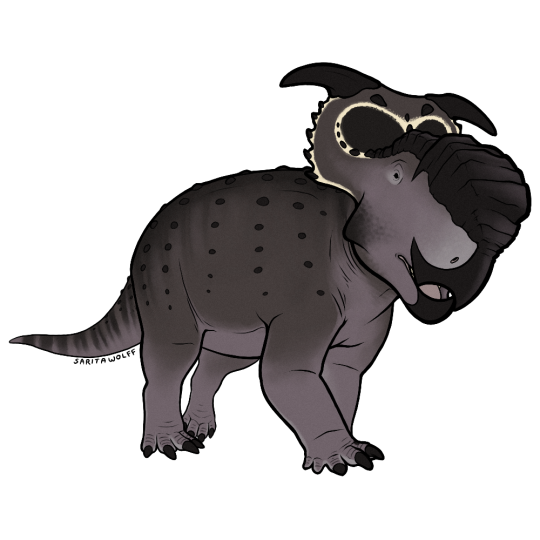
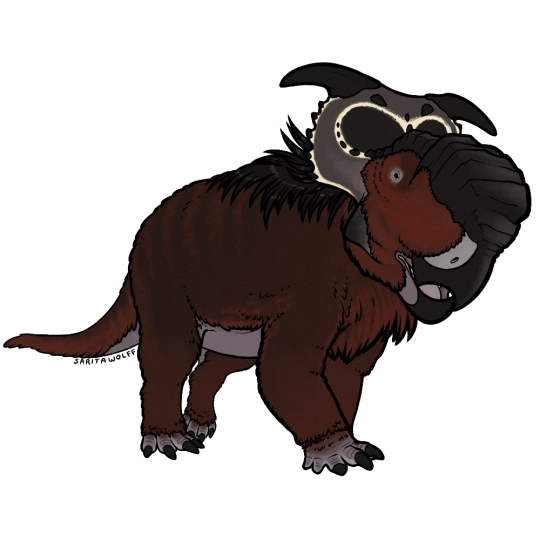
A Patreon request for rome.and.stuff (Instagram) - Pachyrhinosaurus perotorum… that I went a bit overboard with lol. I’ve been waiting for an excuse to draw my favorite ceratopsian, and to digitally adapt my old Pachy marker drawing design.
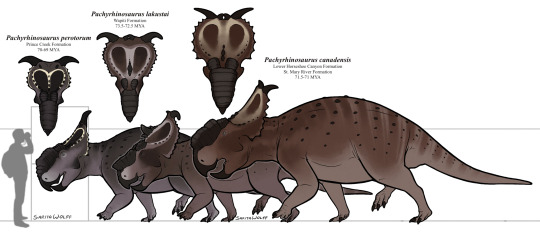
So! Pachyrhinosaurus! As seen above, there were three known species of Pachyrhinosaurus, living in different locations and eras in Late Cretaceous North America.
The oldest, P. lakustai, was native to the Wapiti Formation of Alberta and British Columbia, Canada. It’s known for the extra spikes it has at the center of its frill.
The slightly younger P. canadensis was native to the lower Horseshoe Canyon Formation and the St. Mary River Formation of Alberta and northwestern Montana. It was the largest of the three.
The youngest, P. perotorum, was native to the Prince Creek Formation of Alaska. As this ceratopsid seemingly stayed put during the long, dark, cold Alaskan Winters, it likely had adaptations for keeping warm.

The depiction of a “woolly” Pachyrhinosaurus was first popularized by Mark Witton as a speculative work, but the trope has prevailed. While many paleontologists find a heavy feather covering on a centrosaurine to be highly unlikely, and maintain that the animal’s size and homeothermy would have kept it warm enough, we still have no skin impressions to suggest that P. perotorum was fully scaly. So a feather coating is not completely out of the question (though it is unlikely). Still, I love the look of a woolly Pachyrhinosaurus and how it challenges our previous conceptions of non-avian dinosaurs. Stranger things exist in nature. I had to include a “woolly” option, especially since I already use the guy as my avatar on my paleo Instagram account, SaritaPaleo.
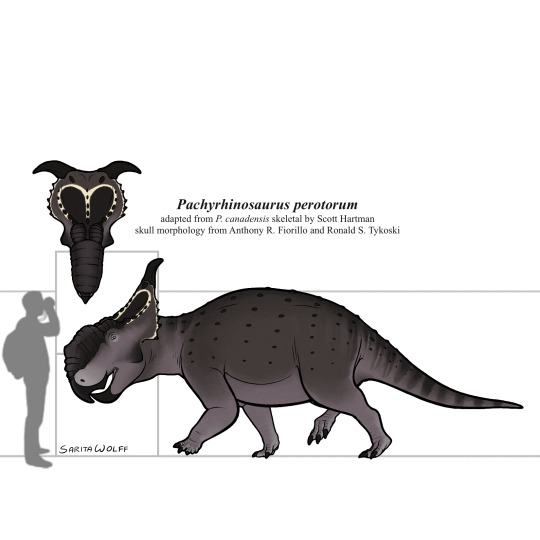
Pachyrhinosaurus was particularly unique in that it seemingly traded off something that had previously worked for other ceratopsians, horns, for a large nasal boss instead. For Pachyrhinosaurus, a battering ram worked better than a sword.
It was herbivorous, using its strong cheek teeth to chew tough, fibrous plants. Perhaps during the dark and cold Winters, P. perotorum would have also dug for roots or even scavenged carcasses. At any rate, from observations of their unusually conspicuous growth banding, it appears growth for P. perotorum would have been stunted during the harsh Winter, but was extremely rapid in the warmer months, an adaptation for the Alaskan climate.
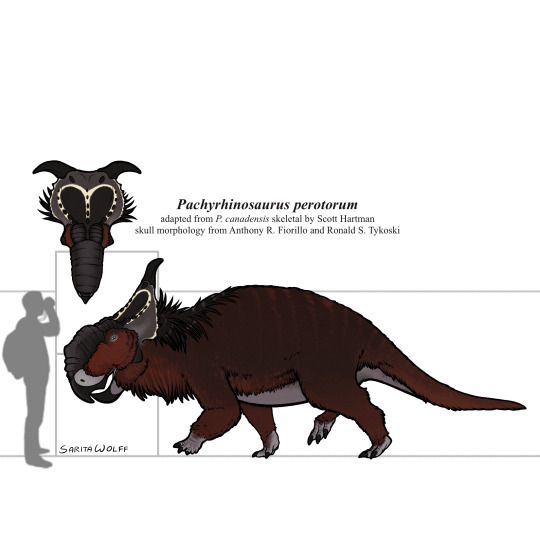
The tundra of the Prince Creek Formation housed a surprising amount of diversity. Pachyrhinosaurus perotorum would have lived alongside smaller ceratopsians like Leptoceratopsids, as well as other ornithischians like the pachycephalosaurine Alaskacephale and the hadrosaurid Edmontosaurus. Theropods such as Dromaeosaurus and Saurornitholestes, as well as a yet unidentified giant Troodontid, lived here as well. P. perotorum’s main predator would have been the tyrannosaur Nanuqsaurus. Small mammals were also somewhat common here, such as Cimolodon, Gypsonictops, Sikuomys, Unnuakomys, and an indeterminate marsupial.
(Btw, the request tier for Patreon starts at only $5 a month. 😉 Link is pinned at the top of my blog.)
#my art#SaritaDrawsPalaeo#Pachyrhinosaurus#Pachyrhinosaurus perotorum#Pachyrhinosaurus lakustai#Pachyrhinosaurus canadensis#Centrosaurines#ceratopsians#ceratopsids#ornithischians#dinosaurs#archosaurs#archosauromorphs#reptiles#Prince Creek Formation#Wapiti Formation#Horseshoe Canyon Formation#St. Mary River Formation#Late Cretaceous#Canada#United States of America
78 notes
·
View notes
Text
(This is said with love and not criticism, as a science educator who has an ear for this sort of thing)
Did Matt get a source of science facts recently? Did he start listening to a podcast or reading a new book? (He is also one degree of separation from Hank Green...?)
I've been noticing him incorporating or dropping little nuggets of knowledge that he hasn't really used in the past. I love caecilians and was THRILLED to see one Alaskan Bull Worm sized as a DnD monster! I've never seen them in media before and especially not in their full resplendent gross-ness.
Then the little nuggets this episode- someone asking "aren't hippos more deadly than lions?" And Matt going "They ARE!" With the delight of someone who made a purposeful choice based on research. And the mention of brightly colored animals tending to be warning of toxins but not necessarily the same of plants.
Anyway I'm really excited to see what he does with it- classic fantasy staples are made so much better and scarier when you include tidbits of real animals' biology and behavior!
#critical role#cr cast#matt mercer#cr spoilers#ish#c3e74#you literally cant make some of this shit up#hagfish battle WHEN#my posts#50
64 notes
·
View notes
Text
The Mockingbirds Song |Chapter 1|

Pairing: Hybrid!Taehyung x Hybrid!F!Reader
Chapter warnings: nothing really :)
Summary: You had fled from your old home, your old owner, your old life in hopes you’ll find a better one. You ran as far as you could, as much as you could, until you couldn’t. Left for dead, you have no hopes you’ll make it to see the light of the morning.
Genre: angst, fluff…
Word count: 1k
Hybrid types: Reader: Omega!Red wolf, Namjoon: Alpha!Eurasian wolf, Yoongi: Omega!Alaskan Tundra wolf,Hoseok: Alpha!Steppe wolf Jin: Beta!Great Plains wolf, Jimin: Omega!Northwestern wolf Jungkook: Beta!Arctic wolf, Taehyung: Alpha!Alexander archipelago wolf
A/n: I’m really excited to start this series, like I have a feeling it’s actually going to be a good series 😁
I recommend reading the teaser first, as it is more so a intro to the story than it is a teaser!
Credit to @cafekitsune for the dividers!
Next - Masterlist

You whimper, your body feels so stiff. You hear muffled voices, yet you can’t bring yourself to open your eyes. Your mind is running a mile a minute, screaming at you to Get up! but you can’t find it in you to. You attempt to shift onto your side—wait, your side? You didn’t black out on your back. You jolt upright, wincing at the pain that courses through you. Your gaze lands on seven bodies all watching you intently.
You whimper, backing up against the couch. “Hey hey hey, no no we’re not gonna hurt you. We’re hybrids too.” At the man’s words your gaze flickers to the tops of all their heads. They are. “We found you in the woods..well I should say Taehyung found you and brought you back here.” You look at the man that’s gestured too. He’s watching you closely, brows furrowed with a small pout tugging at his lips.
“T-thank you for taking me here but…why did you?” You ask, your voice a bit hoarse from disuse. “Well you didn’t look very good, your neck had slight bruising on it, and your body just..” The man, now known as Taehyung, trails off, his concerned eyes never once leaving your form. “What were you doing out in the woods?” Another voice speaks up. You turn your head to the source, finding cold eyes boring into yours.
You swallow nervously, gaze lowering to your lap to avoid the man’s. “I-I ran away..” You mumble, playing with your fingers. “From what?” The man asks again. You consider not responding, frowning as you mull over what to do. “You don’t have to say anything. The important thing is you're safe now.” Another man speaks up, reaching out and putting a reassuring hand on yours.
You flinch, a small, barely there flinch yet the man quickly takes his hand back. “Sorry..” You mumble, relaxing back into the couch as best as you can. “No no, don’t apologize.” You look up to see a frown on the man’s face. You quickly look back down, fiddling with your hands. You bring your tail into your lap, gently combing your fingers through it as you press your ears to your head, a form of comfort for you.
“What kind of hybrid are you?” One of the men speaks up, earning a smack from another. “Kook!” One of the men whisper harshly. “I-I’m a red wolf..” You mumble, keeping your eyes firmly planted on your fingers working out the small tangles in your tail. You hear a small gasp from someone, “Like the really rare one?” You nod, nibbling on your bottom lip. “Coolio!” One of them say, jumping up from the floor making you look up.
“I’m an arctic wolf.” The man says, sitting by you on the couch with a wide smile. You look up at him, giving him a small smile in return. You haven’t met another wolf in years. “I’m Jungkook.” He says, extending a hand in your direction. You take it hesitantly, giving it a weak shake before letting go. He starts to point at the men on the floor, “That’s Jimin, that’s Jin, that’s Namjoon, that’s Yoongi, that’s Hobi, and that’s Taehyung.” You follow Jungkook’s finger over all the men, doing your best to match the names with faces in your head.
They all give you a small, little awkward wave with a small smile. You give them all a smile, “Thank you all for helping me, but how do I get out of here?” You ask, regretting your question when you see some of their faces fall ever so slightly, the sour change in their scents becoming more and more prominent. “I, uhm, can show you.” One of the men, Jin says as he gets up. You nod, standing up from the couch.
You wince, struggling to keep your balance when one of the men, Taehyung, reaches out, steadying you. “I don’t think you should go yet. You can hardly stand.” Taehyung says, holding you gently by your forearms. Your legs wobble and you wince as you move to take a step. “I-I’m fine.” You mumble, attempting to move closer to Jin. Taehyung hesitantly lets you go, hovering nearby.
You move to take another step and lose your balance, pinching your eyes shut as you wait to make contact with the ground. You open your eyes when you don’t, feeling yourself being pressed against a chest before you’re moved back to the couch. “Yeah, sorry but you're not leaving. At Least not until you can walk properly again.” Taehyung says, sitting on the floor in front of you.
You nod, looking down at your lap. “Are you hungry?” You look up at the voice, about to deny when your stomach betrays you. You look away, flustered, as the man laughs. “I’ll take that as a yes.” The man says before walking away. “What happened to you? I know you said you’d run away but..” Taehyung asks, his concerned eyes foaming over your form.
“I uh..I fell.” You mumble. It isn’t a complete lie, but it’s not the full truth either. “And your neck?” Taehyung asks, his eyes flitting down to your bruised skin. You press your ears to your head, combing your fingers through your tail. “I um…it was the fall?” You mumble, nervously looking up at Taehyung. He frowns, eyeing your neck. “Weird. They look like hand prints.” He mumbles, pursing his lips. You avert your eyes to your tail laying in your lap, pursing your lips as tears cloud your vision.
“Did you..did you have an abusive owner?” Taehyung mumbles, tilting his head to try and catch your gaze. You bite back a sob, a single tear slipping down your cheek. “Hey hey hey..it’s okay. They can’t reach you now.” Taehyung mumbles, his brows furrowing. At this the sob escapes you, making you curl in on yourself. You miss the concerned glances the men in front of you exchange, all of them eyeing your shaking figure worriedly.
“Is she okay? I heard a sob.” The man who’d previously left the room returns, a frying pan in hand as he eyes everyone. Taehyung sighs, sparing you one last glance before standing up and leading the man out of the room.

Next - Masterlist
A/n: I’m sorry it’s a short chapter, but I made like a mini drabble type of chapter with Tae talking to Jin in the kitchen.
If anyone would like to be on a taglist for this series please let me know!
58 notes
·
View notes